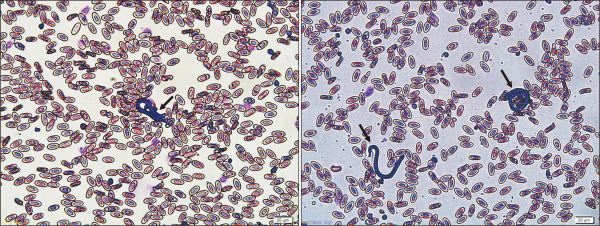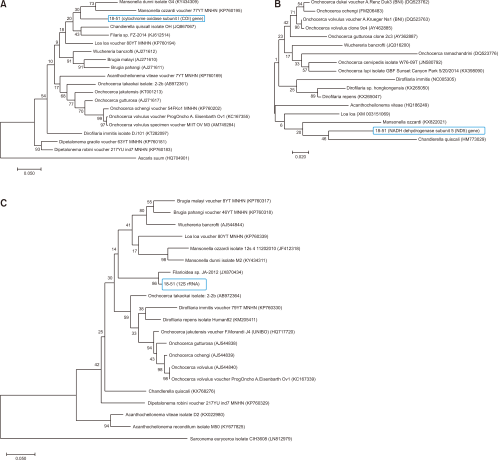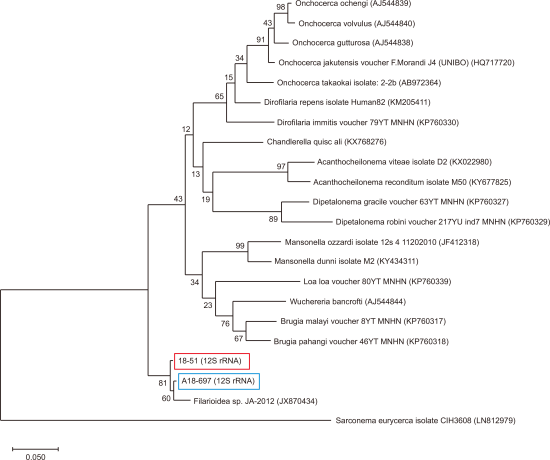Introduction
Filariasis is an infectious disease that occurs in different hosts and is caused by filarial nematodes of the Filarioidea superfamily. The family Onchocercidae (Filarioidea) includes many genera associated with infectious agents that target animals and humans (Chandy et al., 2011; Lefoulon et al., 2015), including Chandlerella quiscali, Sarconema eurycerca, and Pelecitus spp., which have been reported from avian species (Granath, 1980; Muñoz-García et al., 2018; Woo et al., 2010). Huang et al. (2017) listed approximately 16 genera of filariae that occur in avian species. In Korea, the few reports of filarial nematodes in avian species include a recent report of infection by S. eurycerca (Woo et al., 2010).
Although filarial nematode-associated diseases and their pathogenicity have not been clearly demonstrated in avian species, filarial nematode infection in emaciated owls has been previously reported (Larrat et al., 2012). Thus, additional studies should be conducted on the pathogenic potential of filariasis in avian species. Moreover, Suh et al. (2016) found ancient horizontal transfer of retrotransposons between birds and ancestors of human pathogenic nematodes, the insect-borne filarial nematodes Brugia, Wuchereria, and Loa. These ancient interactions between birds and the ancestors of the causative agents of lymphatic filariasis and loiasis in humans highlight the need for additional screening of bird-infecting filarial nematodes to cope with unexpected filariasis in humans. In this study, we report the occurrence of a novel filarial nematode from the family Onchocercidae in the falcated duck (Anas falcata), which is a wild species with a very wide geographical range and an estimated global extent of occurrence (Pan et al., 2014).
Materials|Methods
Sample collection
A wild A. falcata (sample no. 18-51) individual that was unable to fly was found near a parking lot in Seosan City, Chungnam Province, South Korea, on January 31, 2018 (36°59´40.4˝N, 126°26´37.6˝E). Although it presented no sign of external trauma, the bird died on arrival when it was transported to the Chungnam Wild Animal Rescue Center. Its body condition score, which reflects nutritional status, was 1/5, with almost no pectoral muscle.
Blood was collected from the bird’s heart and stored in a 2-mL EDTA-coated tube, which was frozen at −20°C to prevent clotting. For the blood smear, 95% alcohol was used to remove fat and contaminants. One drop of blood was placed on the slides and smeared thin. The blood smear was dried and stained with Diff-Quick dye (Sysmex, Kobe, Japan). blood smear was then observed under a microscope (IX71S1F-3, OLYMPUS CORPORATION).
PCR and sequence analysis
DNA was extracted from the blood samples using a DNeasy Blood & Tissue Kit (QIAGEN, Hilden, Germany). To obtain genetic information on filarial nematodes in the blood, the extracted DNA was analyzed by polymerase chain reaction (PCR) for different target sequences (18S rRNA, cytochrome C oxidase subunit I (COI), NADH dehydrogenase subunit 5, and 12S rRNA) using primers from previous studies (Hamer et al., 2013; Kuzmin et al., 2017; Morales-Hojas et al., 2006; Verocai et al., 2017). Upon observing positive bands from the PCRs, all amplicons were sequenced and subjected to a nucleotide BLAST search on the National Center for Biotechnology Information web server. The GenBank accession numbers of the retrieved partial sequences were MK424345, MK424346, MK424347, and MK424348.
A maximum likelihood phylogenetic analysis was performed using the generated COI, NADH dehydrogenase subunit 5, and 12S rRNA sequences and other Onchocercidae sequences using BioEdit and MEGA version 7.0 (Hall, 1999; Kumar et al., 2016).
Additional screening of filarial nematodes in other wild birds in 2018
To estimate the detection rate of filarial nematodes in the blood of wild birds, 105 wild bird blood samples collected in 2018 at Chungnam Wild Animal Rescue Center were also tested by PCR targeting the 12S rRNA and NADH dehydrogenase subunit 5 genes (Table 1).
Results and Discussion
The blood smear showed the presence of filarial nematodes (Fig. 1). The filarial nematodes were approximately 60 μm in size and were tentatively named filarial nematode 18-51. The PCR using the DNA extracted from the blood resulted positive for the filarial nematode-specific (18S rRNA and COI) and Onchocercidae family-specific targets (12S rRNA and NADH dehydrogenase subunit 5).
The BLAST analysis showed that the partial 18S rRNA and COI sequences from filarial nematode 18-51 were highly similar to those of Onchocercidae sp. MI1-GLH-2012 and Filarioidea sp. JA-2012, with 99.78% and 94.26% identity, respectively. The NADH dehydrogenase subunit 5 and 12S rRNA sequences from filarial nematode 18-51 were similar to those of Onchocerca dukei voucher A. Renz Duk3 and Filarioidea sp. JA-2012, with 90.88% and 97.99% identity, respectively.
The phylogenetic analysis placed filarial nematode 18-51 in Onchocercidae (Fig. 2). The analysis using COI showed filarial nematode 18-51 as closely related to Mansonella species, Filaria sp. FZ-2014, and C. quiscali, with 86.5-89.2% sequence identity. A similar result was found using NADH dehydrogenase subunit 5; filarial nematode 18-51 was found to be closely related to Mansonella ozzardi and C. quiscali, with 85.0% and 85.7% sequence identity, respectively. However, the phylogenetic analysis based on 12S rRNA did not recover filarial nematode 18-51 in Onchocercidae, but only as closely related to Filarioidea sp. JA-2012 (JX870434). These results indicate that filarial nematode 18-51 may belong to a novel genus in the family Onchocercidae, closely related to Mansonella spp. and C. quiscali. Genome sequencing is needed to clearly define the species and genus of the filarial nematode (18-51) found in this study.
Genetic screening of the 105 individual samples from 36 avian species collected in 2018 revealed only one blood sample (A18-697, Anser albifrons) as positive for the Onchocercidae family-specific sequence (12S rRNA gene; Table 1, Fig. 3). Similar to filarial nematode 18-51, this partial 12S rRNA sequence placed the Onchocercidae sample, named A18-697, as distantly related to other genera in the Onchocercidae family. The PCR targeting the NADH dehydrogenase subunit 5 gene in the 105 samples retrieved no positive results. These findings may indicate that filariasis caused by Onchocercidae was not common in wild birds in Korea, or that the nematodes were present in blood below the detection limits of the PCRs. However, the phylogenetic analysis using the 12S rRNA partial placed 18-51 and A18-679 in the same clade as Filarioidea sp. JA-2012 (JX870434), which indicates that they may be a novel genus of Onchocercidae that must be monitored in wild birds.
Several previous studies have reported filarial nematodes in Korea. Brugia malayi, for instance, is a filarial nematode infecting humans in Korea and was previously endemic to several areas of Korea (Chai et al., 2003). Although the filarial nematode S. eurycerca was found in wild whooper swans in Korea (Woo et al., 2010), there are no previous reports of Onchocercidae filarial nematodes in wild birds in Korea. Notably, Huang et al. (2017) reported a novel filarial nematode in Taiwan infecting Eclectus roratus (PC-15-498); the filarial nematode (18-51) found in the present study may be closely related to this E. roratus filariae (PC-15-498), as the latter was also found to be closely related to Filaria sp. FZ-2014 and C. quiscali in a phylogenetic analysis based on the mitochondrial COI gene fragment. Microfilariae found in blood are not typically considered pathogenic in avian species (Huang et al., 2017). Moreover, the present study did not demonstrate the pathogenic relationship between filarial nematode 18-51 and Anas falcata. Nevertheless, additional studies on this filarial nematode in other organs and tissues of the infected individuals are necessary to evaluate its pathogenic potential in avian species.
The present study reports the detection of a filarial nematode of the family Onchocercidae in a wild bird species (A. falcata) in Korea. This filarial nematode may belong to a novel genus closely related to Mansonella spp., C. quiscali, and to recently reported filarial nematodes such as Filaria sp. FZ-2014 and JA-2012, which are found in avian species worldwide. Further studies on the taxonomy of this species, as well as on its prevalence and pathogenic potential in avian species, are necessary.
Acknowledgments
This study was supported by the Bio & Medical Technology Development Program of the National Research Foundation (NRF) funded by the Ministry of Science and ICT (NRF-2018M3A9H4056347), and by the BioNano Health-Guard Research Center, funded by the Ministry of Science and ICT (MSIT) of Korea as a Global Frontier Project (Grant No. H-GUARD_2013M3A6B2078954).
Figures and Table
Fig. 1
Light microscopy image of filarial nematodes in a blood smear from the Anas falcata inidividual examined in this study. The filarial nematodes (approximately 60 μm in length) are indicated by arrows. On average, the avian red blood cells measured approximately 13.5×7.5 µm (long×short axis).

Fig. 2
Phylogenetic trees based on the partial sequences of cytochrome c oxidase subunit I (A), NADH dehydrogenase subunit 5 (B), and 12S rRNA (C) genes. Blue boxes indicate the filarial nematode (sample no. 18-51) found in this study. The maximum likelihood analysis was performed including other Onchocercidae filarial nematodes using the Tamura-Nei model. The trees shown have the highest log likelihood and are drawn to scale, with branch lengths representing the number of substitutions per site.

Fig. 3
Phylogenetic trees based on partial sequences (348 bp) of the 12S rRNA gene. The red box indicates filarial nematode 18-51, and the blue box indicates the positive sample obtained from the screening of the 105 wild bird samples (i.e., A18-697). The maximum likelihood analysis was performed including other Onchocercidae filarial nematodes using the Tamura-Nei model. The tree has the highest log likelihood (−2566.79) and is drawn to scale, with branch lengths representing the number of substitutions per site.

Table 1
Sample information for the additional screening of filarial nematodes
| Avian species | Number of samples |
PCR- positives* |
|---|---|---|
| Anser albifrons | 5 | 1 |
| Anas platyrhynchos | 1 | 0 |
| Cygnus cygnus | 2 | 0 |
| Anser fabalis | 1 | 0 |
| Bubo bubo | 7 | 0 |
| Accipiter nisus | 3 | 0 |
| Falco tinnunculus | 7 | 0 |
| Botaurus stellaris | 1 | 0 |
| Egretta garzetta | 1 | 0 |
| Aegypius monachus | 28 | 0 |
| Ardea alba modesta | 1 | 0 |
| Anas falcata | 1 | 0 |
| Accipiter gentilis | 2 | 0 |
| Accipiter nisus | 1 | 0 |
| Bucephala clangula | 1 | 0 |
| Cygnus olor | 1 | 0 |
| Buteo buteo | 4 | 0 |
| Falco peregrinus | 1 | 0 |
| Pica sericea | 3 | 0 |
| Larus crassirostris | 1 | 0 |
| Otus bakkamoena | 1 | 0 |
| Otus scops | 6 | 0 |
| Ninox scutulata | 4 | 0 |
| Streptopelia orientalis | 6 | 0 |
| Columba livia | 1 | 0 |
| Zoothera dauma | 1 | 0 |
| Phasianus colchicus | 1 | 0 |
| Falco subbuteo | 2 | 0 |
| Ardea cinerea | 1 | 0 |
| Bubulcus ibis | 3 | 0 |
| Garrulus glandarius | 1 | 0 |
| Butorides striata | 1 | 0 |
| Numenius phaeopus | 1 | 0 |
| Anas poecilorhyncha | 2 | 0 |
| Strix aluco | 1 | 0 |
| Ixobrychus eurhythmus | 1 | 0 |
| Total | 105 | 1 |